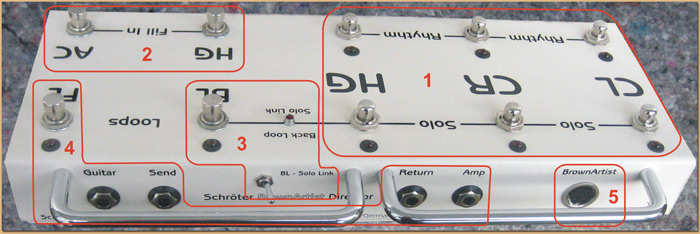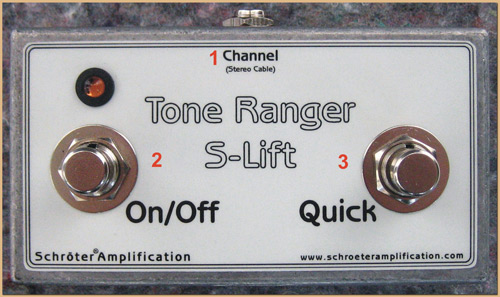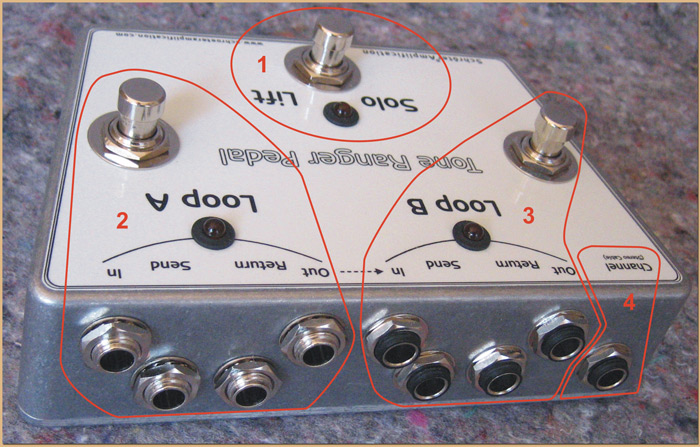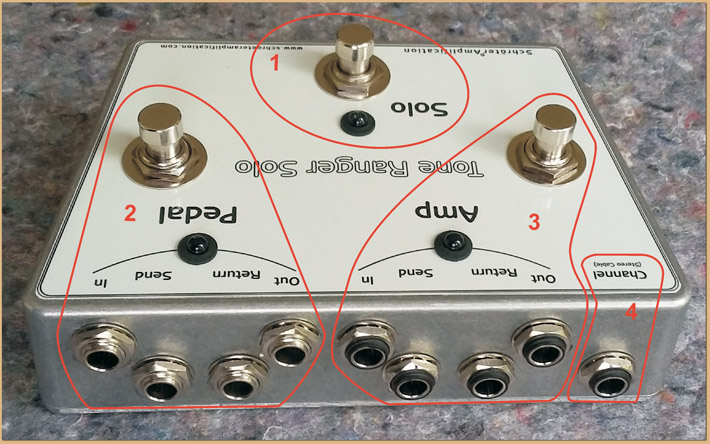Footswitches
The Director is a very flexible and reliable analogue control center with integrated True Hardware Bypass Loop for the Schröter® BrownArtist and Schröter® Traditional Amps.
- With it, each of the 3 channels of the amps can be accessed directly in the solo or the rhythm volume.
- With the two Fill In buttons can be emphasized free of switching stress short solo throw-in.
- It activates / deactivates the amp's effects loop manually or automatically for solo volumes.
- Its True Hardware Bypass Loop provides sound neutrality as long as effects are not needed between guitar and amp, and is used to simultaneously activate / deactivate effects chains. Or, alternatively, the guitar signal can be routed to a tuner for silent tuning or just to change the guitar silently.
- The metal bars effectively protect all connected cables from "missteps."
- With it, each of the 3 channels of the amps can be accessed directly in the solo or the rhythm volume.
- With the two Fill In buttons can be emphasized free of switching stress short solo throw-in.
- It activates / deactivates the amp's effects loop manually or automatically for solo volumes.
- Its True Hardware Bypass Loop provides sound neutrality as long as effects are not needed between guitar and amp, and is used to simultaneously activate / deactivate effects chains. Or, alternatively, the guitar signal can be routed to a tuner for silent tuning or just to change the guitar silently.
- The metal bars effectively protect all connected cables from "missteps."

EUR 480,00
1 - Channel Button
For each of the CL -Clean, CR-Crunch and HG-High Gain channels, there is a rhythm button in the bottom row and a solo button in the top row. This means that each channel can be selected directly without an intermediate step in a rhythm or solo volume.
2 - Fill In Button
In the lower row to the right are the so-called Fill In buttons. You activate the solo volume (SoloVol on the amp) only as long as the foot is on the button. The AC-Active Channel button makes the currently active rhythm channel louder and HG always selects the high-gain channel in solo volume, no matter which rhythm channel is currently playing.
3 - Back Loop
When the Back Loop Solo Link LED is lit, preselected by the BL-Solo Link toggle switch on the front panel of the Director, the amp's effects loop is activated simultaneously by selecting a solo volume or pressing a Fill In button. In addition, the effect can also be completely independent manually switched on / off with the switch BL in the top row.
4 - FrontLoop
The FL front loop to the right switches the True Hardware Bypass Loop, which is integrated in the Director, for looping effect devices between guitar and amp on / off. To use them, the guitar is plugged into the Guitar jack and the Amp jack is connected to the Guitar jack on the Amp, and the effects units hang between the Send and the Return jacks.
5 - (BrownArtist) 7-pin DIN socket
The screw-on 7-pin DIN connector (BrownArtist) connects to the Director connector on the amp back panel. It sends switching commands that only the BrownArtist or the Traditional understand (noMIDI jack!).
M4 Mounting Holes (not shown) There are four M4 threaded holes on the bottom to mount the Director on a floorboard.
For each of the CL -Clean, CR-Crunch and HG-High Gain channels, there is a rhythm button in the bottom row and a solo button in the top row. This means that each channel can be selected directly without an intermediate step in a rhythm or solo volume.
2 - Fill In Button
In the lower row to the right are the so-called Fill In buttons. You activate the solo volume (SoloVol on the amp) only as long as the foot is on the button. The AC-Active Channel button makes the currently active rhythm channel louder and HG always selects the high-gain channel in solo volume, no matter which rhythm channel is currently playing.
3 - Back Loop
When the Back Loop Solo Link LED is lit, preselected by the BL-Solo Link toggle switch on the front panel of the Director, the amp's effects loop is activated simultaneously by selecting a solo volume or pressing a Fill In button. In addition, the effect can also be completely independent manually switched on / off with the switch BL in the top row.
4 - Front
The FL front loop to the right switches the True Hardware Bypass Loop, which is integrated in the Director, for looping effect devices between guitar and amp on / off. To use them, the guitar is plugged into the Guitar jack and the Amp jack is connected to the Guitar jack on the Amp, and the effects units hang between the Send and the Return jacks.
5 - (BrownArtist) 7-pin DIN socket
The screw-on 7-pin DIN connector (BrownArtist) connects to the Director connector on the amp back panel. It sends switching commands that only the BrownArtist or the Traditional understand (no
M4 Mounting Holes (not shown) There are four M4 threaded holes on the bottom to mount the Director on a floorboard.
Schröter® Tone Ranger S-Lift

The Tone Ranger S-Lift is included with the Tone Ranger.
It activates / deactivates the amp's S-Lift either with On / Off permanently or with Quick, only while the foot is on the button.
It activates / deactivates the amp's S-Lift either with On / Off permanently or with Quick, only while the foot is on the button.

(EUR 80,00) included with the Tone Ranger
1 - Channel jack
2 - On / Off switch
This switch permanently activates the S-Lift of the Tone Ranger until you deactivate it with another kick. If the LED is lit, the 2nd volume (=solo volume) of the amp is selected.
3 - Quick button
This is a momentary switch. This means that the solo volume of the Tone Ranger is activated as long as the foot is on the button. When unloaded, the rhythm volume of the amp is active again and the LED on the footswitch and the amp are dark.
This feature is very useful for short parts like solo licks that should be highlighted in volume. Since the foot can "rest" on the button, it works without any switching stress, because you do not have to look down.
Here, the Tone Ranger S-Lift is connected to the footswitch jack of the Tone Ranger amp via a normal stereo cable. It is powered by the amp and also leads the control signal for the S-lift. In case of emergency, a normal mono-jack cable (guitar cable) could be used. The functions of the pedal are retained, but are not displayed by the LED.
2 - On / Off switch
This switch permanently activates the S-Lift of the Tone Ranger until you deactivate it with another kick. If the LED is lit, the 2nd volume (=solo volume) of the amp is selected.
3 - Quick button
This is a momentary switch. This means that the solo volume of the Tone Ranger is activated as long as the foot is on the button. When unloaded, the rhythm volume of the amp is active again and the LED on the footswitch and the amp are dark.
This feature is very useful for short parts like solo licks that should be highlighted in volume. Since the foot can "rest" on the button, it works without any switching stress, because you do not have to look down.
Schröter® Tone Ranger Pedal

The Tone Ranger pedal is optionally available for the Tone Ranger.
It controls the solo lift and provides two super sound neutral and independent True Hardware Bypass loops.
These can be used together in series between guitar and amp input, or together in series in the loop of the amp.
Most interesting, however, is thatLoop A lets you manage one or more effect devices between guitar and amp input while Loop B does that in the loop of the amp!
The signal path, so the arrangement of the effects, is then the same as with the "4-cable method":
Guitar - Effects - Tone Ranger Preamp - Effects - Tone Rangers power amp
The arrangement of the switches allows to switch without difficulty either a single switch, the S-Lift and a loop or all three switches simultaneously.
It controls the solo lift and provides two super sound neutral and independent True Hardware Bypass loops.
These can be used together in series between guitar and amp input, or together in series in the loop of the amp.
Most interesting, however, is that
The signal path, so the arrangement of the effects, is then the same as with the "4-cable method":
Guitar - Effects - Tone Ranger Preamp - Effects - Tone Rangers power amp
The arrangement of the switches allows to switch without difficulty either a single switch, the S-Lift and a loop or all three switches simultaneously.

EUR 190,00 (S-lift pedal can be credited with EUR 80,00)
1 - Solo Lift
This switch activates and deactivates the S-Lift of the Tone Ranger. If the LED is lit, it is active and the second volume of the amp is selected.
This switch activates and deactivates the S-Lift of the Tone Ranger. If the LED is lit, it is active and the second volume of the amp is selected.
2 - Loop A
If the Out jack ofLoop A or the In jack of Loop B is not assigned, both loops are internally connected in series and can be used together in front of the amp or in the loop of the amp. In front of the amp, the In jack is connected to the guitar and the Out jack of Loop B to a Amp input. In the effects loop, the send of the amp is connected to the in jack of the loop A and the return is connected to the out jack of the loop B.
Effect devices are then each between the send and return jacks of the two loops.
If you only want to use Loop A "in front of the amp", ie between guitar and amp input (hot or cool), the guitar will be connected to the In jack of Loop A and its Out jack will be connected to the input of the amp. Effect devices then hang between the send and return jacks of theLoop A.
TheLoop A as A / B Box!
Loop A can also be used as an A / B box, "forward," where a source is routed to either destination A or B, or "backward," where source A or B are sent to a destination.
3 - Loop B
Although the Loop B works basically the same as Loop A in True Hardware Bypass technology, but has isolated sjacks and is wired inside a little differently. This allows the Loop B to be used in the loop of the amp without ground loop problems whileLoop A is used in front of the amp.
The effects loop of the Tone Ranger is thus remoteable!
4 - Channel Jack
If the Out jack of
Effect devices are then each between the send and return jacks of the two loops.
If you only want to use Loop A "in front of the amp", ie between guitar and amp input (hot or cool), the guitar will be connected to the In jack of Loop A and its Out jack will be connected to the input of the amp. Effect devices then hang between the send and return jacks of the
The
Loop A can also be used as an A / B box, "forward," where a source is routed to either destination A or B, or "backward," where source A or B are sent to a destination.
3 - Loop B
Although the Loop B works basically the same as Loop A in True Hardware Bypass technology, but has isolated sjacks and is wired inside a little differently. This allows the Loop B to be used in the loop of the amp without ground loop problems while
The effects loop of the Tone Ranger is thus remoteable!
4 - Channel Jack
Here, the Tone Ranger Pedal is connected to the footswitch jack of the Tone Ranger amp via a normal stereo cable. It is powered by the amp and also leads the control signal for the S-lift. In case of emergency, a normal mono-jack cable (guitar cable) could be used. The functions of the pedal are retained, but are not displayed by the LEDs.
Schröter® Tone Ranger Solo Pedal
The Tone Ranger Solo pedal is optionally available for the Tone Ranger.
It controls the S-Lift and has two super sound neutral and independent True Hardware Bypass loops ready - as well as the Tone Ranger Pedal - but differs in two ways.
Point 1:
The loops can not be used together in series. The loop "Pedal" works exclusively between guitar and amp input and the loop "Amp" in the effects loop of the amp. Thus, the signal path is equal to the "4-cable method":
Guitar - Effects - Tone Ranger Preamp - Effects - Tone Ranger Power Amp
It controls the S-Lift and has two super sound neutral and independent True Hardware Bypass loops ready - as well as the Tone Ranger Pedal - but differs in two ways.
Point 1:
The loops can not be used together in series. The loop "Pedal" works exclusively between guitar and amp input and the loop "Amp" in the effects loop of the amp. Thus, the signal path is equal to the "4-cable method":
Guitar - Effects - Tone Ranger Preamp - Effects - Tone Ranger Power Amp
In the middle of the Tone Ranger Pedal the "Solo-Lift" button is located. For the Tone Ranger Solo pedal this button is called "Solo".
With a kick, it activates not only the Tone Rangers S-Lift but simultaneously both loops, too.
For example, if you typically have a distortion/booster pedal in the loop Pedal and a delay effect in the loop Amp, the amp is quite comfortable with a kick in solo volume and the "lead channel" enriched with delay is on.
One can say with the Solo switch, you can toggle between a rhythm and a solo preset.
The Tone Ranger Solo pedal is not as universally applicable as the Tone Ranger pedal, but is designed specifically for those who want to switch between rhythm and solo play more comfortably.
Of course, however, each loop can be switched independently with their respective switch on / off.
For example, if you typically have a distortion/booster pedal in the loop Pedal and a delay effect in the loop Amp, the amp is quite comfortable with a kick in solo volume and the "lead channel" enriched with delay is on.
One can say with the Solo switch, you can toggle between a rhythm and a solo preset.
The Tone Ranger Solo pedal is not as universally applicable as the Tone Ranger pedal, but is designed specifically for those who want to switch between rhythm and solo play more comfortably.
Of course, however, each loop can be switched independently with their respective switch on / off.

EUR 190,00 (S-lift pedal can be credited with EUR 80,00)
1 - Solo
This switch simultaneously activates and deactivates the Tone Rangers Solo Lift and both loops. The on / off status is indicated by the LED. (The LEDs of the loops stay dark)
2 - Loop Pedal
The loop "Pedal" manages one or more effect devices between guitar and amp input.
To do this, the guitar is connected to the in jack of the loop and its out jack to the input (hot or cool) of the amp. The input of the (first) effect device is connected to the send jack and the output of the (last) effect device to the return jack. When the loop is activated, the LED lights up.
3 - Loop Amp
The "Amp" loop manages one or more effect units in the Tone Rangers loop.
For this, the send jack of the amp is connected to the In jack of this loop and its Out jack to the return jack of the amp. The input of the (first) effect unit is connected to the send jack of the pedal and the output of the (last) effect unit to the return jack of the pedal. When the loop is activated, the LED lights up.
If the effects loop of the Tone Ranger is operated in parallel, the wiring looks a bit different:
The send jack of the amp is connected to the In jack of the loop and the input of the effect unit to the send jack of the pedal. The output of the effect unit is now connected directly to the return jack of the amp.
Note: Typically, when operating an effects loop in parallel with an amp, the effect unit should not send a direct signal (kill dry switch) but only the pure effect signal. For a delay only the echo repeats should be sent or for a reverb only the pure reverb tail, because the direct signal internally in the amp already exists. If you ignore this, you have two direct signals, which can lead to phase shifts (hollow sound),but in any case, the whole amp gets louder, instead of only making the effect signal louder.
4 - Channel Jack
Here, the Tone Ranger Solo pedal is connected to the footswitch jack of the Tone Ranger amp via a normal stereo cable. It is powered by the amp and also leads the control signal for the S-lift. In case of emergency, a normal mono-jack cable (guitar cable) could be used. The functions of the pedal are retained, but are not displayed by the LEDs.